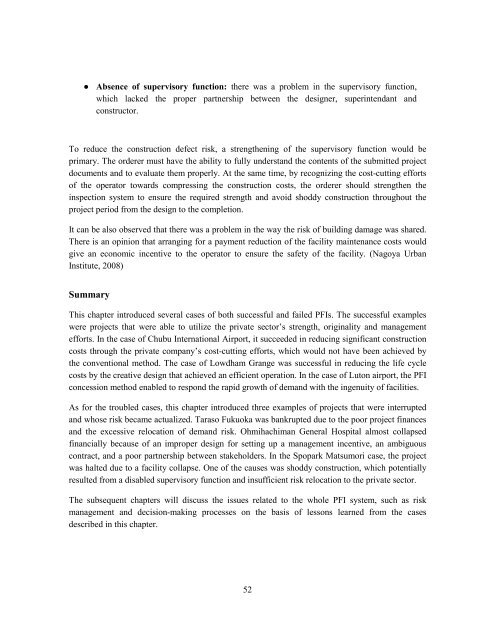Risk Management and Governance for PFI Project ... - Title Page - MIT
Risk Management and Governance for PFI Project ... - Title Page - MIT
Risk Management and Governance for PFI Project ... - Title Page - MIT
You also want an ePaper? Increase the reach of your titles
YUMPU automatically turns print PDFs into web optimized ePapers that Google loves.
● Absence of supervisory function: there was a problem in the supervisory function,<br />
which lacked the proper partnership between the designer, superintendant <strong>and</strong><br />
constructor.<br />
To reduce the construction defect risk, a strengthening of the supervisory function would be<br />
primary. The orderer must have the ability to fully underst<strong>and</strong> the contents of the submitted project<br />
documents <strong>and</strong> to evaluate them properly. At the same time, by recognizing the cost-cutting ef<strong>for</strong>ts<br />
of the operator towards compressing the construction costs, the orderer should strengthen the<br />
inspection system to ensure the required strength <strong>and</strong> avoid shoddy construction throughout the<br />
project period from the design to the completion.<br />
It can be also observed that there was a problem in the way the risk of building damage was shared.<br />
There is an opinion that arranging <strong>for</strong> a payment reduction of the facility maintenance costs would<br />
give an economic incentive to the operator to ensure the safety of the facility. (Nagoya Urban<br />
Institute, 2008)<br />
Summary<br />
This chapter introduced several cases of both successful <strong>and</strong> failed <strong>PFI</strong>s. The successful examples<br />
were projects that were able to utilize the private sector’s strength, originality <strong>and</strong> management<br />
ef<strong>for</strong>ts. In the case of Chubu International Airport, it succeeded in reducing significant construction<br />
costs through the private company’s cost-cutting ef<strong>for</strong>ts, which would not have been achieved by<br />
the conventional method. The case of Lowdham Grange was successful in reducing the life cycle<br />
costs by the creative design that achieved an efficient operation. In the case of Luton airport, the <strong>PFI</strong><br />
concession method enabled to respond the rapid growth of dem<strong>and</strong> with the ingenuity of facilities.<br />
As <strong>for</strong> the troubled cases, this chapter introduced three examples of projects that were interrupted<br />
<strong>and</strong> whose risk became actualized. Taraso Fukuoka was bankrupted due to the poor project finances<br />
<strong>and</strong> the excessive relocation of dem<strong>and</strong> risk. Ohmihachiman General Hospital almost collapsed<br />
financially because of an improper design <strong>for</strong> setting up a management incentive, an ambiguous<br />
contract, <strong>and</strong> a poor partnership between stakeholders. In the Spopark Matsumori case, the project<br />
was halted due to a facility collapse. One of the causes was shoddy construction, which potentially<br />
resulted from a disabled supervisory function <strong>and</strong> insufficient risk relocation to the private sector.<br />
The subsequent chapters will discuss the issues related to the whole <strong>PFI</strong> system, such as risk<br />
management <strong>and</strong> decision-making processes on the basis of lessons learned from the cases<br />
described in this chapter.<br />
52

















